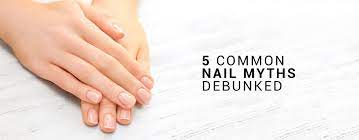Nail Care
Nail Care Myths Debunked: What Works for Your Nails 2023
Contents
- 1 Nail Care Myths Debunked: What Works for Your Nails
- 2 Understanding Nail Anatomy and Growth
- 3 5 facts about nails Nail Cutting Myths 1: Cutting Cuticles Promotes Nail Growth
- 4 Nail Care Myth 2: White Spots Indicate Calcium Deficiency
- 5 Nail Care Myth 3: Frequent Manicures Damage Nails
- 6 Nail Care Myth 4: Nails Need to Breathe
- 7 Nail Care Myth 5: Nail Hardeners Prevent Breakage
- 8 Nail Care Myths Debunked
Nail Care Myths Debunked: What Works for Your Nails
This article seeks to clarify common nail care misconceptions and provide accurate information. A solid grasp of nail facts is crucial for creating an efficient nail care routine. By dispelling widespread misunderstandings and substituting them with evidence-based realities, we can assist you in attaining the solid and healthy nails you desire.
Understanding Nail Anatomy and Growth
Understanding the anatomy of nails and the growth process is essential to differentiate between nail care myths and facts. Pins comprise keratin, a protein; change occurs from the nail matrix under the cuticle. Understanding the structure and development of nails can dispel misconceptions and lead to better decisions regarding nail care. With this knowledge, we can develop more effective strategies for maintaining healthy nails.
5 facts about nails
Nail Cutting Myths 1: Cutting Cuticles Promotes Nail Growth
There is a common belief that cutting cuticles promotes nail growth. Still, cuticles act as a protective barrier for the nail matrix, safeguarding it from bacteria and potential harm. For optimal nail care, it is recommended to push back cuticles gently after bathing or showering, as they are softer and more pliable now. This method can help avoid damage to the nail bed and promote healthy growth.
Nail Care Myth 2: White Spots Indicate Calcium Deficiency
While there is a common belief that white spots on nails indicate a lack of calcium, these spots are usually caused by minor injuries to the nail bed rather than a sign of a nutrient deficiency. Calcium is necessary for overall health, but its lack would display differently before impacting your nails. Nevertheless, if you observe the recurrence of white spots and have any apprehensions, it’s recommended to seek advice from a healthcare expert to obtain accurate nail care information.
Nail Care Myth 3: Frequent Manicures Damage Nails
There is a myth that regular manicures can harm nails, but the truth is that it’s the harsh chemicals in some nail products that can weaken them with prolonged use. A proper nail care routine involves choosing quality, non-harmful products for manicuring, moisturizing nails, and giving them breaks between manicure sessions. These habits can promote healthy and strong nails.
Nail Care Myth 4: Nails Need to Breathe
The idea that nails require oxygen to stay healthy is a common myth in nail care. Nails consist of non-living cells and receive nutrients from the bloodstream, not the air. Oxygen is not necessary for their growth or maintenance. The repeated use of nail polish can cause dryness and discolouration, but a lack of oxygen does not cause this. Proper care and hydration of the nail surface are essential for effective nail care.
Nail Care Myth 5: Nail Hardeners Prevent Breakage
There is a common belief that nail hardeners prevent breakage, but it is important to note that while they may offer temporary hardness, excessive use can result in brittle nails. Brittleness is due to the presence of formaldehyde in many hardeners, which can cause nails to become overly complex and prone to breakage. Therefore, keeping them moisturized and consuming a diet high in proteins and vitamins is recommended to promote healthy nails. Doing so can help maintain your nails’ natural strength and flexibility, reducing the likelihood of breakage.
Nail Care Myths Debunked
Nail care myths can lead to ineffective practices, but with accurate information, we can establish a successful regimen that enhances the health and strength of our nails. By presenting factual information and dispelling common myths about nail care, we aim to guide you toward healthier nails. It is important to remember that proper nail care is not just about appearance but also plays a crucial role in overall health and hygiene. We aim to keep you informed and healthy as we work together towards achieving more robust, healthier nails.
Education Resource: Mayo Clinic
Nail Cutting Myths 1: Cutting Cuticles Promotes Nail Growth
There is a common belief that cutting cuticles promotes nail growth. Still, cuticles act as a protective barrier for the nail matrix, safeguarding it from bacteria and potential harm. For optimal nail care, it is recommended to push back cuticles gently after bathing or showering, as they are softer and more pliable now. This method can help avoid damage to the nail bed and promote healthy growth.
Nail Care Myth 2: White Spots Indicate Calcium Deficiency
While there is a common belief that white spots on nails indicate a lack of calcium, these spots are usually caused by minor injuries to the nail bed rather than a sign of a nutrient deficiency. Calcium is necessary for overall health, but its lack would display differently before impacting your nails. Nevertheless, if you observe the recurrence of white spots and have any apprehensions, it’s recommended to seek advice from a healthcare expert to obtain accurate nail care information.
Nail Care Myth 3: Frequent Manicures Damage Nails
There is a myth that regular manicures can harm nails, but the truth is that it’s the harsh chemicals in some nail products that can weaken them with prolonged use. A proper nail care routine involves choosing quality, non-harmful products for manicuring, moisturizing nails, and giving them breaks between manicure sessions. These habits can promote healthy and strong nails.
Nail Care Myth 4: Nails Need to Breathe
The idea that nails require oxygen to stay healthy is a common myth in nail care. Nails consist of non-living cells and receive nutrients from the bloodstream, not the air. Oxygen is not necessary for their growth or maintenance. The repeated use of nail polish can cause dryness and discolouration, but a lack of oxygen does not cause this. Proper care and hydration of the nail surface are essential for effective nail care.
Nail Care Myth 5: Nail Hardeners Prevent Breakage
There is a common belief that nail hardeners prevent breakage, but it is important to note that while they may offer temporary hardness, excessive use can result in brittle nails. Brittleness is due to the presence of formaldehyde in many hardeners, which can cause nails to become overly complex and prone to breakage. Therefore, keeping them moisturized and consuming a diet high in proteins and vitamins is recommended to promote healthy nails. Doing so can help maintain your nails’ natural strength and flexibility, reducing the likelihood of breakage.
Nail Care Myths Debunked
Nail care myths can lead to ineffective practices, but with accurate information, we can establish a successful regimen that enhances the health and strength of our nails. By presenting factual information and dispelling common myths about nail care, we aim to guide you toward healthier nails. It is important to remember that proper nail care is not just about appearance but also plays a crucial role in overall health and hygiene. We aim to keep you informed and healthy as we work together towards achieving more robust, healthier nails.

